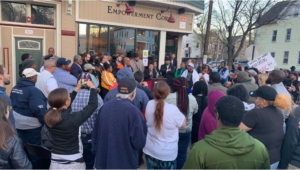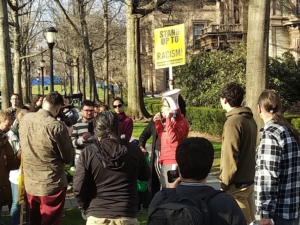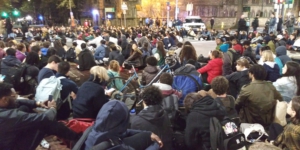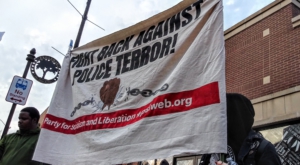On April 16 at 4:29 am, Hamden and Yale police converged on a young couple’s vehicle in New Haven, Connecticut. Without warning, officers from both departments began firing on the vehicle, leaving 22-year-old Stephanie Washington severely wounded and 21-year-old Paul Witherspoon III traumatized. Across New Haven and Hamden, communities mobilized to demand answers and justice.
After the shooting, details slowly began to come out. Washington and Witherspoon were followed into the Newhallville neighborhood of New Haven. The Hamden officer, Devin Eaton, had called for backup not from the New Haven police department, but from Yale. Police vehicles from Hamden and Yale PD boxed in their car without turning on their lights or sirens. An officer from each department jumped out — Eaton from the Hamden PD and Terrance Pollock from the Yale PD — and after Witherspoon attempted to exit the vehicle, they both began shooting. Witherspoon was not hit by any of the dozen or more bullets, but Washington was severely wounded and taken to the hospital in critical condition. A local security camera captured the horrifying footage of the Hamden officer discharging round after round at the vehicle while running away without looking. Later, a second video was released showing that the Hamden police officer Eaton fired on the car first.
The community responded immediately: over the course of four days, people came together to fight back from multiple organizations including People Against Police Brutality, Black Lives Matter New Haven, the Party for Socialism and Liberation, Unidad Latina en Accion, Justice for Jayson, as well as many other community members and groups.
Day one: The people mobilize

Around 5:30 pm on April 16, a large group of outraged residents and local activists shut down a section of Dixwell Avenue in front of the Hamden police department to demand “Justice for Stephanie and Paul.” The protest was led by multiple community members and organizations including People Against Police Brutality, My Brother’s Keeper and the PSL.
Holding signs and megaphones outside the Hamden Police Department, the crowd of over 200 demanded the release of the dashcam and bodycam footage of the shooting, the immediate firing of the cops involved and a transparent and independent investigation.
Local organizer Kerry Ellington demanded the release of footage from another incident similar to this one as well, in which Jarelle Gibbs was killed in a horrifically violent and bloody police chase in August of 2018. She led the crowd in a chant of “Release the footage now!” Jarelle Gibbs’s family members attended the demonstration in solidarity.
From the Hamden Police Department, the protest moved to the location of the incident, outside the Believe In Me Empowerment Corporation on Dixwell Avenue in New Haven. One of the interns from BIMEC told Liberation News that when she arrived at work around 11 am, officers were still investigating the scene and vehicle. The worker, Sharoda Worby-Selim, was outraged at the officers’ actions. “One way or another,” she said, “this can’t keep happening.”
At the scene, representatives from the New Haven and Hamden police departments and the mayors of both cities spoke, claiming that they cannot release the dashcam footage. When Hamden mayor Curt Leng said that there was footage that even he was not allowed to see, multiple voices in the crowd spoke out, calling out the obvious and immediate lack of transparency in the process. “If he’s saying even he can’t see it, that means they’ve got something to hide. They found something on that footage and they’re trying to cover it up,” a rally attendee said.
According to the ACLU, there are no legal barriers to dashcam or bodycam footage being released to the public.
“To date, there have been over 19 people killed by police across Connecticut in the past two years alone and countless survivors of police violence.” Kerry Ellington continued her speech on the steps of BIMEC.
The people then began a march up and down Dixwell Avenue. Veronica Eichler, a vocal concerned resident, told Liberation News that this happens too frequently. “Hamden needs to stay out of New Haven. This violates our rights as New Haven residents.” She pointed out that during the protest, New Haven police stopped on their side of the city line, which is exactly what Hamden does not do.
“No justice, no peace, no racist police”— Shelton Tucker, an activist against police violence in New Haven, led the chant throughout all the protests. He noted that these shootings have been happening for the 20 years he’s lived in the city. “They’re just passing the culture down to the new officers coming to this department.”
Back at the scene of the shooting, Rabbi Brian Immerman, noting that with Passover beginning soon, said, “We are not free when anyone is in chains. People are still in chains from another pharaoh.”
“Every time they pull someone over it has the potential to be a tragedy like this,” Shelton Tucker told the crowd outside the Hamden Police Department.
The investigation has been brought to the state police’s Central District Major Crime Squad.
Day two: Yale on notice

Protests demanding that the footage be released, the officers be fired and the investigation be transparent were continued throughout the week. On April 17, protesters occupied the street and sidewalk outside of Yale president Peter Salovey’s house. The community demanded that Salovey exit the house and address them. Two Yale police officers stood at the front gate preventing any entry. PSL member IV Staklo spoke, urging the increasingly growing crowd to bring out people in their own circles and get them involved in the struggle. “Seek out the people for whom this is somehow new. Let them know the names aren’t just hashtags,” they said. “We are against all systems that benefit off this terror. This is not a time for division. We are being terrorized.”
Another local activist, Jeannia Fu, recounted an incident where she had to intervene when police surrounded a group of Black children, whose bikes were on the ground around them. “Police terror looks like armed adults surrounding a group of children,” she said.
The action grew as a new group of people came up Hillhouse Avenue to join. PSL organizer Jamarr Jabari spoke about his own experiences with police violence. “We are someone’s child. Someone’s family. This was an assassination attempt.”
Salovey never exited his house. Organizers encouraged protesters to email and imessage the Yale president to express their concern. He can be found at [email protected] .
Day three: The movement swells

On day three, a massive number of Yale students joined the New Haven community on the university campus, where students and community members spoke about Yale’s role in the gentrification and police abuse of the city. The group of over one thousand people then marched to the intersection of Broadway and Elm Street, where the Yale campus meets the shopping center of New Haven. The group split into two, yelling call-and-reply chants while kneeling in the street. New Haven police gave the group a warning, telling them that protesters who continued to kneel in the street would be arrested. The protesters linked arms and held their ground.
The police revoked this warning, choosing instead to close off the streets. The protesters stood to form a circle, but the numbers were so great that the line of people with linked arms spread across an entire five way intersection. The protesters chanted “Out of the dorms, into the streets,” and were met with even more students joining, some bringing drums and one bringing a guitar.
This rally continued until midnight; the people marched around the city and almost onto the nearby highway. Norman Clement, an Indigenous elder and organizer with the ANSWER—Act Now to Stop War and End Racism— Coalition, told the crowd that he had been arrested and brutalized by police at a similar protest in 2017. He emphasized that if this gathering had been only New Haven activists, the police would have attacked the action long ago. Organizers reminded Yale students repeatedly that their participation allowed the action to have more power and last longer because police were hesitant to attack a crowd of Yalies. “We will shut down business as usual until we get demands met!” Ellington and other activists led the chants throughout the night.
On the third day, the community also learned that Stephanie Washington successfully made it through surgery and Paul Witherspoon was planning on suing both police departments that shot at them.
Day four: Shutting down Hamden
On the fourth consecutive day of rallies, the energy had not subsided — it was even greater. The organizers and community members were all exhausted, but still going strong. “We will be occupying Hamden’s business center, we will be stopping Hamden business until we get justice!” Ellington addressed the crowd of over five hundred people gathered in the Hamden Plaza, which sits at the start of the “Golden Mile”, Hamden’s largest shopping area.

Norman Clement reminded the crowd that the plaza stood on Quinnipiac land. “There was a genocide on Native people on this spot right here and we are witnessing it again.” He spoke about the bloody history of the United States and the racism it was built on, from the genocide perpetrated against Indigenous people to the enslavement and disenfranchisement of Black people.
The group began marching down the Golden Mile to the Hamden Police Headquarters in a strategic formation shielding Black marchers from the police that swarmed the march. The march stopped multiple times, notably for a long time in front of Stop & Shop to support the striking workers and cheer them on, and was met with equally enthusiastic cheers from the picket line.
Kerry Ellington, Reverend Scott Marks, comedian Taylor Grate, musician Thabisa Rich and ANSWER organizers Chris Garaffa and Jamarr Jabari led the march with chants of “Police say get back? We say fight back!”, “How do you spell guilty? HPD!” and “Justice for Stephanie! Justice for Paul!” Marks and Rich led the crowd in a spirited song: “Ain’t gonna let nobody turn me around, we gonna keep on walkin’, keep on talkin’, until we get the body cam!”
The march landed on the stone steps of the police headquarters shortly after sunset, meeting a blockade of police vehicles.
The activists spoke atop the steps, lit up by flashing red and blue lights. They urged the crowd of protesters not to stop fighting after the protest — the fight needs to continue. “You can’t hear the fire in my soul,” Shelton Tucker’s words were raspy and quiet after four consecutive days of rallies. He also pointed out that this action alone won’t do anything to change the system. He said the continued need for these events was “disheartening”. His first protest was for Malik Jones 22 years ago, another victim of police brutality by Hamden Police in New Haven. The officer had received a silver shield award. “This is not a sprint. This is a marathon,” he continued.
One mother brought her child onto the steps of the Hamden PD to demand that police get out of the Hamden middle school that her daughter attends. Her fifth grade daughter spoke, showing her fear and anger of police with guns roaming her school.
Michelle Gibbs also spoke about the trauma from losing her brother Jarelle in a deadly police chase by Hamden officers in August 2018, and the pain she feels daily when she has to go to work in Hamden and see the officers responsible for his death.
Justin Farmer, a Hamden councilperson, addressed the need for a Civilian Review Board. He said that in order to do this for the town of Hamden, a charter revision would have to be made. He asked the crowd if they would support changing all these town laws, and they agreed with him that it needed to be done.
What’s next for Connecticut?
The organizers informed the crowd of upcoming dates to continue the fight. Each action demonstrated a profound solidarity between struggles: at each turn, community members remembered the need for unity with the immigrant rights struggle, with trans and queer communities and the fight for workers’ rights.
Instead of going to church on Easter Sunday, many people are attending “church in the wild,” and holding a rally at the scene of the shooting. There are additional dates of city hall meetings in which protesters are urged to attend, where they will continue to speak out against the injustices of this triple occupation of Newhallville.





